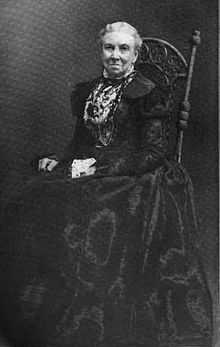Bathsheba W. Smith
| Bathsheba W. Smith | ||
|---|---|---|
 | ||
| 4th General President of the Relief Society | ||
| November 10, 1901 – September 20, 1910[1] | ||
| Called by | Lorenzo Snow | |
| Predecessor | Zina D. H. Young | |
| Successor | Emmeline B. Wells | |
| Second Counselor of the General Presidency of the Relief Society | ||
| October 11, 1888 – November 10, 1901[1] | ||
| Called by | Zina D. H. Young | |
| Predecessor | Elizabeth Ann Whitney | |
| Successor | Ida S. Dusenberry | |
| Personal details | ||
| Born |
Bathsheba Wilson Bigler May 3, 1822 Shinnston, Virginia,[2] United States | |
| Died |
September 20, 1910 (aged 88) Salt Lake City, Utah, United States | |
| Resting place |
Salt Lake City Cemetery 40°46′38″N 111°51′29″W / 40.7772°N 111.8580°W | |
| Spouse | George A. Smith | |
| Children | 3 | |
| Parents |
Mark Bigler Susannah Ogden | |
| Website | Bathsheba W. Smith | |
|
| ||
Bathsheba Wilson Bigler Smith (3 May 1822 – 20 September 1910) was an early member of the Latter Day Saint movement. She was the fourth general president of the Relief Society of The Church of Jesus Christ of Latter-day Saints (LDS Church), a matron of the Salt Lake Temple, a member of the Board of Directors of Deseret Hospital, Salt Lake City, Utah, and a leader in the western United States woman's suffrage movement.
Biography

Born near Shinnston, Harrison County, Virginia (now West Virginia), she was the daughter of Mark Bigler and Susanna Ogden. These excerpts from her autobiography tell how her family moved from Virginia, first to Missouri, and then to Illinois:
- “My brother, Jacob G. Bigler, having gone to Far West, Missouri, joined the church there and bought a farm for my father, and then returned.”
- “About this time my father sold his farm in West Virginia, and fitted out my mother, my brother and sister Sarah, Melissa and myself, and we started for Far West, Missouri, in company with my two brothers-in-law and my uncle and their families.
- “Father stayed to settle up his business intending to join us at Far West in the spring, bringing with him, by water, farming implements [and] house furniture.
- “Three nights after we had arrived at the farm which my brother had bought, and which was four miles south of the city of Far West, word came that a mob were gathering on Crooked River, and a call was made for men to go out...for the purpose of trying to stop...the mob, who were...destroying and burning property. Cap. David Patten's company went, and a battle ensued.
- “My father had to lose what he had paid on his farm. And in February 1838, in the depth of winter, our family and thousands of the Saints were on the way to the State of Illinois. In the spring, father joined us at Quincy, Illinois.”
On September 23, 1839, her father, Mark Bigler, died in Quincy.

- “In the spring of 1840, our family moved to Nauvoo, in Illinois.”
In Nauvoo, Illinois on 25 July 1841, Bathsheba Bigler married George A. Smith who was the youngest member of the Quorum of the Twelve Apostles of the Church of Jesus Christ of Latter Day Saints at that time. Smith kept a diary and sketchbook for most of her life which included drawings of prominent members of the Latter Day Saint community. Among the best known is a profile of church president Joseph Smith, Jr.
During the succession crisis that occurred after the assassination of Smith, Bathsheba Smith, her husband and two children joined the Latter Day Saint group following Brigham Young. They traveled west and established themselves first in Salt Lake City and then in southern Utah. During the early 1870s, George A. Smith served as first counselor in the Church Presidency under Young. He and his wife traveled to many emerging Mormon settlements, preaching and promoting church affairs.
After the death of her husband in 1875, Smith became active in civic affairs and heavily involved in the women's suffrage movement. She was called to serve as general president of the church's women's organization, the Relief Society in 1901 and served in the position until her death in 1910. She was buried at Salt Lake City Cemetery.
See also
References
- Allen, James B.; Glen M. Leonard (1976). The Story of the Latter-day Saints. Salt Lake City, UT: Deseret Book. ISBN 978-0-87747-594-1.
- Ludlow, Daniel H., Editor. (1992). Church History, Selections from the Encyclopedia of Mormonism. Deseret Book. ISBN 978-0-87579-924-7.
- Peterson, Janet; Gaunt, LaRene (1990). Elect Ladies: Presidents of the Relief Society. Salt Lake City, UT: Deseret Book. ISBN 978-0-87579-416-7.
- ↑ 1.0 1.1 Ludlow, Daniel H, ed. (1992). "Biographical Register of General Church Officers". Encyclopedia of Mormonism. New York: Macmillan Publishing. p. 1646. ISBN 0-02-879602-0. OCLC 24502140 Free on-line version here.
- ↑ Shinnston was part of Virginia until June 20, 1863. See Virginia in the American Civil War:West Virginia splits
External links
![]() Media related to Bathsheba W. Smith at Wikimedia Commons
Media related to Bathsheba W. Smith at Wikimedia Commons
- George A. Smith Family Papers, University of Utah
- Autobiography of Bathsheba W. Smith, University of Utah
- Bathsheba W. Smith at Find a Grave
| The Church of Jesus Christ of Latter-day Saints titles | ||
|---|---|---|
| Preceded by Zina D. H. Young |
President of the Relief Society November 10, 1901–September 20, 1910 |
Succeeded by Emmeline B. Wells |
| Preceded by Elizabeth Ann Whitney |
Second Counselor in the general presidency of the Relief Society October 11, 1888–November 10, 1901 |
Succeeded by Ida S. Dusenberry |
| |||||||||||
|